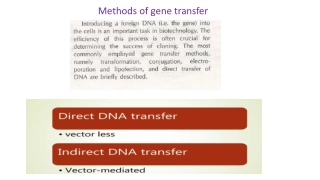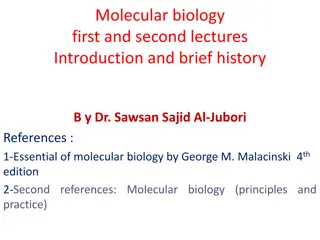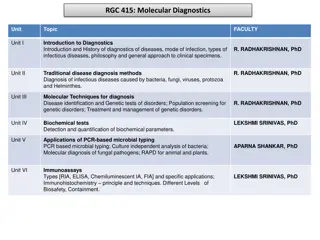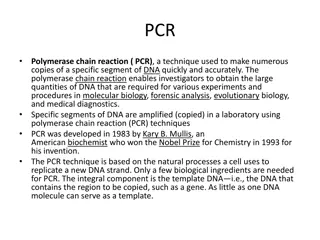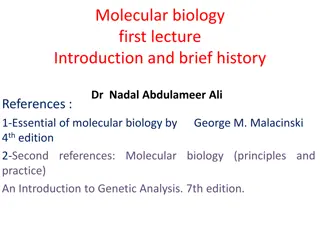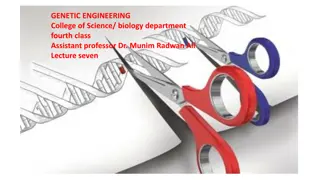Understanding Bacterial Transformation in Molecular Biology
Transformation in molecular biology is a process where genetic material is altered by the uptake of exogenous DNA. It involves the direct incorporation of genetic material into a cell, leading to genetic changes. This phenomenon was first demonstrated by Frederick Griffith in 1928. The process of transformation is crucial for horizontal gene transfer among bacteria and can occur through natural competence or induced in a laboratory setting. Besides bacteria, transformation can also describe the insertion of genetic material into nonbacterial cells. Understanding the mechanisms and implications of transformation is essential in genetic research and biotechnology.
- Bacterial Transformation
- Molecular Biology
- Genetic Alteration
- Horizontal Gene Transfer
- Exogenous DNA
Download Presentation

Please find below an Image/Link to download the presentation.
The content on the website is provided AS IS for your information and personal use only. It may not be sold, licensed, or shared on other websites without obtaining consent from the author. Download presentation by click this link. If you encounter any issues during the download, it is possible that the publisher has removed the file from their server.
E N D
Presentation Transcript
DR. SUDHA KUMARI Assistant Proffecer Department of Veterinary Microbiology Bihar Veterinary College
Transformation Transformation in bacteria was first demonstrated in 1928 by the British bacteriologist Frederick Griffith. Griffith was interested in determining whether injections of heat- killed bacteria could be used to vaccinate mice against pneumonia. Transformation is the process by which genetic makeup of an organism is altered by the insertion of new gene(or exogenous DNA) into its genome . This is usually done using vectors such as plasmids.
Definitions In molecular biology and genetics, transformation is the genetic alteration of a cell resulting from the direct uptake and incorporation of exogenous genetic material from its surroundings through the cell membrane(s). For transformation to take place, the recipient bacterium must be in a state of competence, which might occur in nature as a time-limited response to environmental conditions such as starvation and cell density, and may also be induced in a laboratory.
Transformation is one of three forms of horizontal gene transfer that occur in nature among bacteria, in which DNA encoding for a trait passes from one bacterium to another and is integrated into the recipient genome by homologous recombination; the other two are transduction, carried out by means of a bacteriophage, and conjugation, in which a gene is passed through direct contact between bacteria.
Transformation" may also be used to describe the insertion of new genetic material into nonbacterial cells, including animal and plant cells; however, because "transformation" has a special meaning in relation to animal cells, indicating progression to a cancerous state, the process is usually called "transfection"
In transformation, the genetic material passes through the intervening medium, and uptake is completely dependent on the recipient bacterium. Competence refers to a temporary state of being able to take up exogenous DNA from the environment; it may be induced in a laboratory.
Two types of transformation Natural transformation Natural transformation is a bacterial adaptation for DNA transfer that depends on the expression of numerous bacterial genes whose products appear to be responsible for this process. In general, transformation is a complex, energy-requiring developmental process. In order for a bacterium to bind, take up and recombine exogenous DNA into its chromosome, it must become competent, that is, enter a special physiological state. Artificial transformation - chemical treatment. - physical treatment. - enzymatic treatment.
Methods and mechanisms of transformation in laboratory Bacterial Artificial competence can be induced in laboratory procedures that involve making the cell passively permeable to DNA by exposing it to conditions that do not normally occur in nature. Typically the cells are incubated in a solution containing divalent cations under cold conditions. Yeast Most species of yeast, including Saccharomyces cerevisiae, may be transformed by exogenous DNA in the environment. Several methods have been developed to facilitate this transformation at high frequency in the lab. 1. Yeast cells may be treated with enzymes to degrade their cell wall.
Plants A number of methods are available to transfer DNA into plant cells. Agrobacterium-mediated transformation is the easiest and most simple plant transformation. Plant tissue (often leaves) are cut into small pieces. e.g. 10x10mm, and soaked for ten minutes in a fluid containing suspended Agrobacterium. The bacteria will attach to many of the plant cells exposed by the cut.
In this image, a gene from bacterial cell 1 is moved to bacterial cell 2. This process of bacterial cell 2 taking up new genetic material is called transformation.
Transfection is the process of deliberately introducing naked or purified nucleic acids into eukaryotic cells. It may also refer to other methods and cell types, although other terms are often preferred: "transformation" is typically used to describe non-viral DNA transfer in bacteria and non- animal eukaryotic cells, including plant cells. In animal cells, transfection is the preferred term as transformation is also used to refer to progression to a cancerous state (carcinogenesis) in these cells. Transduction is often used to describe virus-mediated gene transfer into eukaryotic cells.
The methods are divided into 3 categories: 1. Chemical methods Calcium Phosphate - Lipids - Cationic polymer 2. Physical methods - Electroporation - Microinjection - Laserfection - Sonoporation - Biolistic particle delivery Methods of Transfection 3. Biological method - Virus-based
Advantages: 1. Deliver nucleic acids to cells in a culture dish with high efficiency. 2. Easy to use, minimal steps required; adaptable to high- throughput systems. 3. Using a highly active lipid will reduce the cost of lipid and nucleic acid, and achieve effective results. Disadvantage: 1. Not applicable to all cell types 1. Lipid-Mediated Gene Delivery Also referred as lipofection or liposome-based gene transfection. Mode: Uses lipids to cause a cell to absorb exogenous DNA.
The main difference between transfection and transformation. Is that the transfection refers to the introduction of foreign DNA into mammalian cells while the transformation refers to the introduction of foreign DNA into bacterial, yeast or plant cells.


